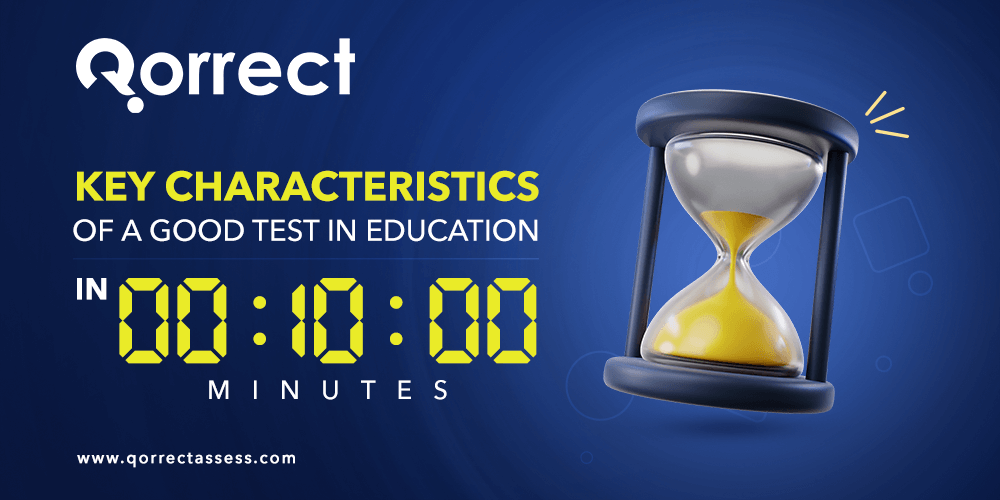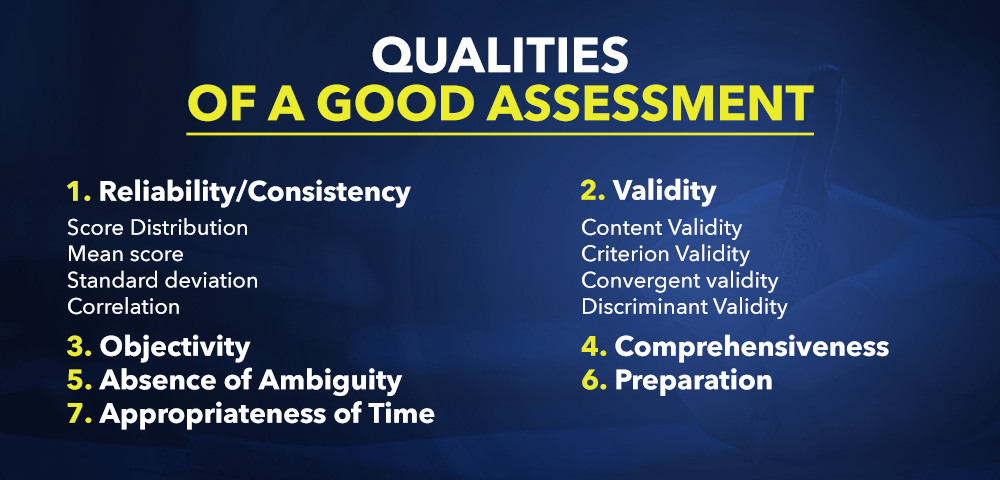Table of Contents
Sticking to as many characteristics of a good test in education as possible is a challenging process for teachers.
In 10 min or less, you’ll get a brief on all commonly agreed upon characteristics, practical ways to employ them in order to make your test reliable, and top of the world universities that use them!
One of the major goals of education is to prepare students for the next step in their future. They have to make sure that their learners have acquired enough knowledge about the field of study. Only good tests ensure this. A good test is not only a score that learners struggle to ace.
It’s feedback a student receives to improve his skills and knowledge and a good teacher loves to get back to, always, to make sure their teaching strategies are on point and whether they need development or not.
It’s also a feedback for decision-makers in all educational institutions and governmental positions who need good data to get to the next step of the institution or the State’s education plan.
It’s not something centric that students spend days of anxiety on, wondering how well they will do in a given test and how well the test questions are actually written and whether they are questions they do know the answer to or not.

What Are the Characteristics of a Good Test in Education?
What is the characteristics of a good test in education? It is an evaluation through which teachers measure learners’ abilities and points of weaknesses and strengths. It gauges their knowledge in the field of study and provides both sides with real feedback.
A good test should ensure that learners are ready to move to the next step whether this step is a high school, college, or even the military.
In our previous event, the first free online webinar, “Ensuring Effective E-Assessment for Higher Education,” Qorrect e-assessment team, discussed the complete cycle of a good test in detail focusing on higher education examination.
The team discussed how to analyze, design, develop, implement, and evaluate the phases that together comprise the e-assessment life cycle, going through the e-assessment life cycle and its importance to higher education, edtech role in the evolution of the digital assessment process.
That’s plus considering the contribution of edtech in improving assessment quality, analysing the examinees’ responses, assessing the exam’s quality and the effectiveness of the involved questions in measuring what they are designed to measure.
Read our article “Why You Shouldn’t Overlook the Importance of Probing Questions in Teaching”
What Are the Qualities of Good Assessment?
An assessment is a process through which students can share their educational experiences. In order for a test to be a good tool for measuring students’ knowledge and skills, it should have the following characteristics of examination that are essential for the success of any test.
Reliability or Consistency
Reliability or consistency of a test means that learners should perform the same or get the same score if they are exposed to different questions in different times and places. A test is considered reliable when the same result is achieved over different tests.
As James Carlson mentions in his research memorandum, “The reliability of test scores is the extent to which they are consistent across different occasions of testing, different editions of the test, or different raters scoring the test taker’s responses.” He also mentions some statistics to describe how a test can be reliable.
How to Make Sure Your Test Is Reliable?
- Score Distribution: The percentage of test takers at each score level.
- Mean Score: The average score, computed by summing the scores of all test takers and dividing by the number of test takers.
- Standard Deviation: A measure of the amount of variation in a set of scores. It can be interpreted as the average distance of scores from the mean. (Actually, it is a special kind of average called a “root mean square,” computed by squaring the distance of each score from the mean score, averaging the squared distances, and then taking the square root.)
- Correlation: A measure of the strength and direction of the relationship between the scores of the same people on two tests.
Reliability is the ratio of the true score and the observed score variance. To measure a test’s reliability, we may administer a test to the same group more than once.
However, errors may occur as students may forget or have some physical problems. Thus, it is crucial to administer the same test in identical conditions to ensure that we will get the same results.
Read “How to Make an Online Exam for Students in Only Minutes”
Validity
A validity of a test can be achieved when the test measures what it is really intended to measure. Therefore, a certain criteria must be selected.
Validity is very important to gauge the quality of a given test as questions must be in line with the selected criteria and measures.
Here are some of the top different types of validity:
Content Validity: A test should fairly represent the content of the course or the field of study.
Criterion Validity: It is used to predict the performance of a job applicant or a student.
Convergent validity: This is mostly used in the field of sociology or psychology.
Discriminant Validity: Discriminant validity means that a test of a concept is not highly correlated with other tests that are set to measure theoretically different concepts.
See how you can make objective, valid tests in education using Qorrect e-assessment system. Reserve a free Demo now.
Objectivity
According to Gronlund and Linn “Objectivity of a test refers to the degree to which equally competent scores obtain the same results,” the test should be away from any personal or subjective judgment. It should be based only on the evaluation of human development.
For example, in an essay-type test, students answer differently as each one has his/her own style of writing.
Hence, when more than one instructor check the test, they may give different scores according to whether they like the style or not. So, here, the test is less objective.
To avoid such bias, sharp rules should be set in evaluating such types of tests. There should be a unified guide for teachers to use while correcting such tests.
Personal judgment does not occur in true or false or multiple choice tests. Besides, teachers should receive training on how to score a test as untrained teachers may give wrong scores and not be able to maintain the required fairness and accuracy.
Read “Standardized Tests: History and Implementation in Universities”
Comprehensiveness
A test should fully cover the entire field of study that students are exposed to during the course. Vague questions should not be included especially during online tests when students are confused and short in time.
Absence of Ambiguity
There has to be no place for ambiguity especially in online tests where examiners are absent. Students should not be left in confusion and all questions have to be crystal clear.
According to Jacobs, Lucy C., from Indiana University, “ambiguous questions constitute the major weakness in college tests.
Ambiguous questions often result when instructors put off writing test questions until the last minute. Careful editing and an independent review of the test items can help to minimize this problem.”
Read “What’s the Difference between Online Exam and Offline Exam?”
Preparation
To ensure the success of any test, instructors should take into consideration the following factors:
- Students have to be well-prepared for the test through extensive revisions and discussions.
- There should not be any gaps between the revision period and the exam.
- Examiners should make it clear to students which topics are expected to be tackled in the exam.
- Students should be well-trained for the test type.
Appropriateness of Time
One of the top characteristics of a good test is when students have appropriate time to answer all questions. For example, essay questions require more time than multiple choice or true/false questions.
Some teachers take the test themselves first and then double or triple the time for students. A good test is supposed to be practical and comprehensive.
Our Conclusion of Characteristics of Good Test
There is a strong sense, however, that the use of the word ‘characteristics’ or ‘criteria’ is not optimal. It implies the development of standards against which assessments could be judged.
Instead, we believe there should be a general agreement that the word ‘framework’ captures our desire to create a structure that might be useful in the development of a good test in education more precisely.

7 Outstanding Characteristics of a Good Online Test
- No logistic setback
- Easy access from anywhere
- High speed
- Support essay questions, multiple-answer questions, short answers, & equation & scientific questions
- Built-in questions bank in quality online test systems
- Immediate students results reports are generated
- Highly detailed, error-free analytics reports on students’ performance as well as test and questions quality
Characteristics of a Good Test with Examples
What Is the Purpose of a Test?
It is an evaluation process through which examiners know who you are and what you know and think. They identify how you are different from others.
Types of Tests
Tests can be categorized into two types according to the questions they tackle:
Essay Questions Tests
- This type is intended to gauge students’ information and knowledge of the field of study. It measures their writing skills and how well they are able to show their personality in writing.
- There should not be anything to be memorized as students answer according to their understanding of the course materials.
- Through this type of tests, instructors are able to measure students’ logical thinking and problem solving skills.
Read “Proctored Exams: Here’s How to Successfully Do Remote Proctoring”
Objective Questions Tests
Such tests are easy to be marked as they have true and false answers and hence they are away from any personal opinion or subjectivity. For example, true or false and multiple choice questions are objective tests.
In an article titled “Harvard Courses Turn to Monitored Exams, Open-Book Assessments, and Faith in Students As Classes Move Online” Juliet E. Isselbacher and Amanda Y. Su, The Crimson writers, showed experiences of different professors through the COVID-19 pandemic and how they were forced to switch to online learning.
Professor Robert N. Stavins decided to change the exam to be open-book so as to guarantee equality among students especially during the absence of any monitoring during the online tests.
Other professors preferred to keep the same old style of the closed-book exam ensuring that it is verified and monitored as professor Chaudoin said “We have to trust the students, and the online exam tools give us a partial way to monitor things.”
Iaura Rose Smith, from the University of Manchester, shared her experience in her article titled “My Online Exam Experience and Top Tips for Students.” She made it clear that online examinations have changed her way of studying.
Instead of just thinking of passing a test, she focused on revision, knowledge, and real understanding of the course material. She said, “I would recommend using this opportunity to gain a deeper understanding of your subject area and expand your knowledge further than the curriculum.”
Verbs Best Used in Good Tests
Educators recommend using a set of key verbs related to Bloom’s theory, classification of educational objectives, when writing any type of test questions/test items.
This list of verbs guarantees that the teacher or test creator is indeed asking the right questions, equivalent to that of the students’ level of knowledge and understanding. Here are some of these verbs, according to California State University website.
| Knowledge | Arrange – define describe – duplicate identify – label – list match – memorize name – order – outline recognize – relate – recall – repeat reproduce – select – state |
| Comprehension | Explain – summarize paraphrase – describe illustrate – classify convert – defend describe – discuss distinguish – estimate explain express – extend – generalized give example(s) -identify – indicate – infer – locate paraphrase – predict recognize – rewrite review – select summarize – translate |
| Application | Use – compute – solve demonstrate – apply construct – apply – change – choose compute – demonstrate discover – dramatize employ – illustrate interpret – manipulate modify – operate practice – predict prepare – produce relate – schedule – show sketch – solve – use – write |
| Analysis | Analyze – categorize compare – contrast separate – apply – change – discover choose – compute demonstrate – dramatize – employ illustrate – interpret manipulate – modify operate – practice predict – prepare produce – relate schedule – show – sketch – solve – use – write |
| Synthesis | Create – design hypothesize – invent develop – arrange assemble – categorize collect – combine comply – compose construct – create design – develop – devise – explain formulate – generate plan – prepare – rearrange – reconstruct relate – reorganize – revise – rewrite – set up – summarize – synthesize – tell – write |
| Evaluation | Judge – recommend critique – justify appraise – argue assess attach – choose – compare – conclude contrast – defend describe – discriminate estimate – evaluate explain – judge – justify interpret – relate – predict – rate – select summarize – support – value |
Qualities of Traditional and Online Assessment
With the exposure of online learning and the use of advanced software systems in education, most instructors had to change the traditional way of testing.
Traditional Assessment
Teachers used to measure students’ knowledge only by how they score in a given exam. They give students only one chance to show their competencies without discussions or classroom projects.
Online Assessment
Online assessment is a way through which teachers can improve students’ learning, knowledge, beliefs, and skills. Online assessments can be behavioral, cognitive, or communicative assessments.
Students may take the online assessment in the classroom or at home and this reduces their stress. New tools are now introduced for instructors to set different types of assessments.
They can use game-based assessments through many tools such as Kahoot, as mentioned in our previous article “11 Best Exam and Assessment Platforms of 2021.”
Teachers can also create polls and activities. Moreover, Google Forms enable teachers to create and grade quizzes. They can choose multiple-choice quizzes or short-answer quizzes.
Some tools also provide teachers with excel reports of students’ grades and feedback can be sent easily to students directly after the exam. Many advanced software systems allow teachers to deliver reliable and cheat-free exams to students and grade them instantly. This saves a lot of time for teachers.
Qorrect (e-exams system) generates automated reports of the test results. To analyze the quality of the test, it provides feedback that no cheating happened during the online exam, and analyzes the performance of the students during the examination.
Read “Summative Assessment Overview, Purposes, and Best Online Software”
How Do I Write a Good Test?
- Be specific
- Do not use ambiguous questions.
- Choose a suitable format for your test.
- Avoid the open-ended questions unless you are willing to accept any answer.
- Choose your words carefully and avoid any ambiguous language.
- Students should know how much each of the questions are worth.
To conclude, teachers should create their exams away from any subjectivity, ambiguity, or lack of comprehensiveness. The appropriate format should be selected to match the course materials and to measure students’ knowledge and skills.
15 Things You Need to Know about the Characteristics of a Good Test in Education
Here are 15 tips the American Board concluded its workshop “Modes of Classroom Assessment” with:
- Bloom’ theory of educational objectives classification, in which cognitive skills exist in a hierarchical order, is important in any assessment.
- Assessment works better when they are ongoing and integrated into instruction as opposed to episodic and marginally referenced to classroom instruction.
- Lots of faculty members use MCQs for their classes because they are able to cover much greater content and in a very short period of time; plus they’re known to be very easy, compared to other questions, and are quick to score.
- Many professors and test managers prefer to use other types of tests to assess their students/examinees: essay, papers or electronic portfolios, projects, presentations tests.
- Both views are not incorrect! However, a great teacher would use all of the previously mentioned assessment forms throughout the academic year.
- The value of tests is much greater and more pronounced when they are performed as a part of a completely comprehensive program that’s designed to enhance learning, progress, performance, and the educational institution’s success
- “A comprehensive assessment-instruction system should contain a variety of assessment techniques.”
- A test can only test what it was formed to assess. So it’s up to the decision-makers to process the data generated from it.
- Summative assessments are called “assessments of learning,” and formative assessments are called “assessment for learning.”
- There should always be a balance between the intellectual skills being assessed.
- Specific and descriptive instructional feedback that will help students to improve their learning and prepare for mastery of the curricular topics are central to effective formative assessments.
- Frequent short tests are more instructionally helpful and provide better assessment data than infrequent extended exams.
- Diagnostic assessments measure a student’s current knowledge and skills for the purpose of identifying a personalized program of learning for that student.
- Quality assessments are valid, reliable and unbiased.
- A test is no better than the quality of items it contains.
Are You Testing Students or Customers?
In their book “The Trouble with Higher Education,” Patrick Smith and Trevor Hussey had a unique outlook on the system of education in general.
The book linked the rise of consumerism with education, addressing the effects this now has on everything learning-related.
That includes how the system of universities works today and the high prices we face today in a lot of top of the world higher ed institutions and universities… too high some students stay in debt for years (although the book addresses education in the UK, a lot of other countries may relate to the issues raised).
It is a significant consequence of these changes that students have come to see themselves as customers. Increasingly their perception is that they are buying a product. This encourages an instrumental view of education: its value lies not in itself but in what it can be used to gain. An education that has to be purchased at great expense is purchased for a purpose, and that purpose is what it will earn. At the very least it must pay for itself.
Because of this we must start to raise the bar for quality education and testing. Because students or customers are now less willing to tolerate less quality education, teaching, facilities, testing, grading, & reporting.
Do you want to see in action how you can employ the characteristics of a good test in education for FREE? Reserve a free demo now.
 Qorrect Blog
Qorrect Blog







